Our short trip will cover the most famous and recognizable bridges of St. Petersburg. We ride a long river. A wash along slender streets along the soft surface of the river network of the Northern capital, meeting at the intersection of Nevsky Prospekt and the river itself. After simple maneuvers, we will follow down the water to the Kryukov Canal to meet the waters of the notorious river. Fontanka, along which we rise to the main river of the city – the Neva. There we will see almost all drawbridges and even greet the Gulf of Finland, almost leaving the river. The tour ends on the Griboedov Canal, from where you will carry the lights of the northern city in your own eyes.
Duration: 3 hours
Start of excursion: 20:00 (8 p.m.)
All true lovers of St. Petersburg species and small canals are found at the Admiralteyskaya metro station and follow in a tourist boat. Breathe out the old stale air from your lungs and prepare them for river and sea freshness. We begin!
As you know, Petersburg is a city of contrasts, but looking at its gray sky, one might think that the “contrast” was confused with another word, but don’t worry: we will find bright colors. The Blue Bridge is the widest bridge in Europe, almost 100 meters wide. The bridge connects the Mariinsky Palace with the space of St. Isaac’s Square.
A wooden bridge existed at this place already at the beginning of the 18th century, but in 1737 a new wooden drawbridge was built in its place according to the design of G. Van Boles. The crossings constructed according to this project had a gap between the wings of the adjustable span for the mast of the mast, which was closed for passage on the bridge with shields. The bridge was painted blue, so in 1738 it received the “color name” existing to this day – Blue. In the middle of the 18th century, Moika embankments “dressed” in granite, rebuilt the bridge, it had three spans and stone supports. In 1807-1818 the bridge was again rebuilt according to the standard design of engineer V.I. Geste. The construction of the bridge with a vault of cast-iron “box” blocks turned out to be reliable, economical and convenient for installation.
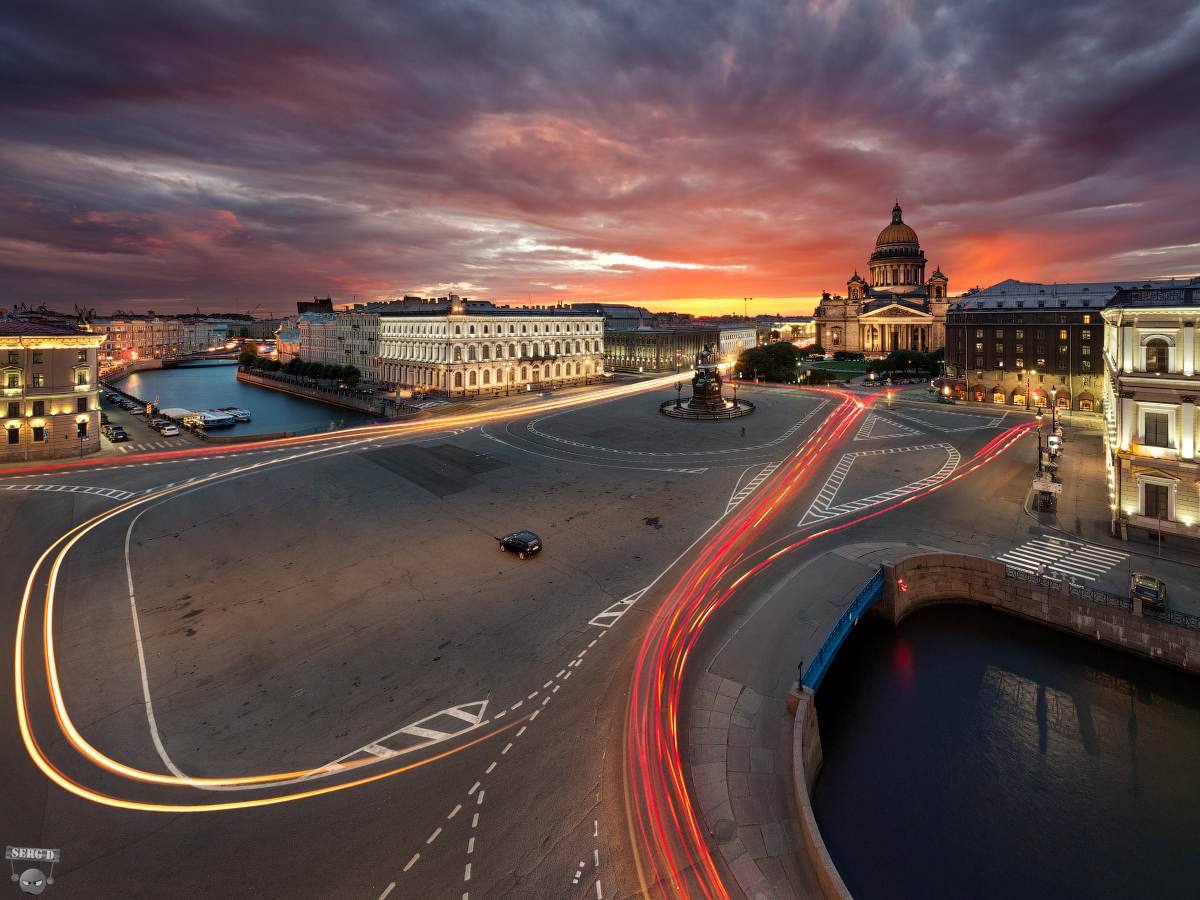
The Blue Bridge
Then we will meet another bridge: the Red Bridge is thrown over the Moika where Gorokhovaya Street crosses the river. The first wooden bridge on this site appeared at the beginning of the XVIII century, but in the 1730s rebuilt according to the project of G. Van Boles. The crossings constructed according to this project had a gap between the wings of the adjustable span for the mast of the mast, which was closed for passage on the bridge with shields. Initially, the bridge was painted white and was called White, but later the bridge was repainted in red, and its “color” name changed. In 1814, the Red Bridge was rebuilt according to the standard design of the engineer V.I. Geste. The construction of the bridge with a vault of cast-iron “box” blocks turned out to be reliable and economical. It was first applied during the reconstruction of Zeleny (Police Bridge) and became the “model” for the construction of cast-iron bridges in St. Petersburg. Cast-iron tubing (boxes) of the bridge were made at the Ural plants of N.N. Demidov. By the 1950s, the construction of the Red Bridge came into disrepair and engineer V.V.Blazhevich developed a project for its restoration. The old cast-iron arch was replaced with new welded arches, while the appearance of the Red Bridge was preserved. In addition, granite obelisks with bronze balls and lanterns were restored, and ancient railings were preserved. The next restoration of the Red Bridge took place in 1989. Today it is the only bridge built from a standard design by V.I.Geste, which has preserved its original appearance to date.
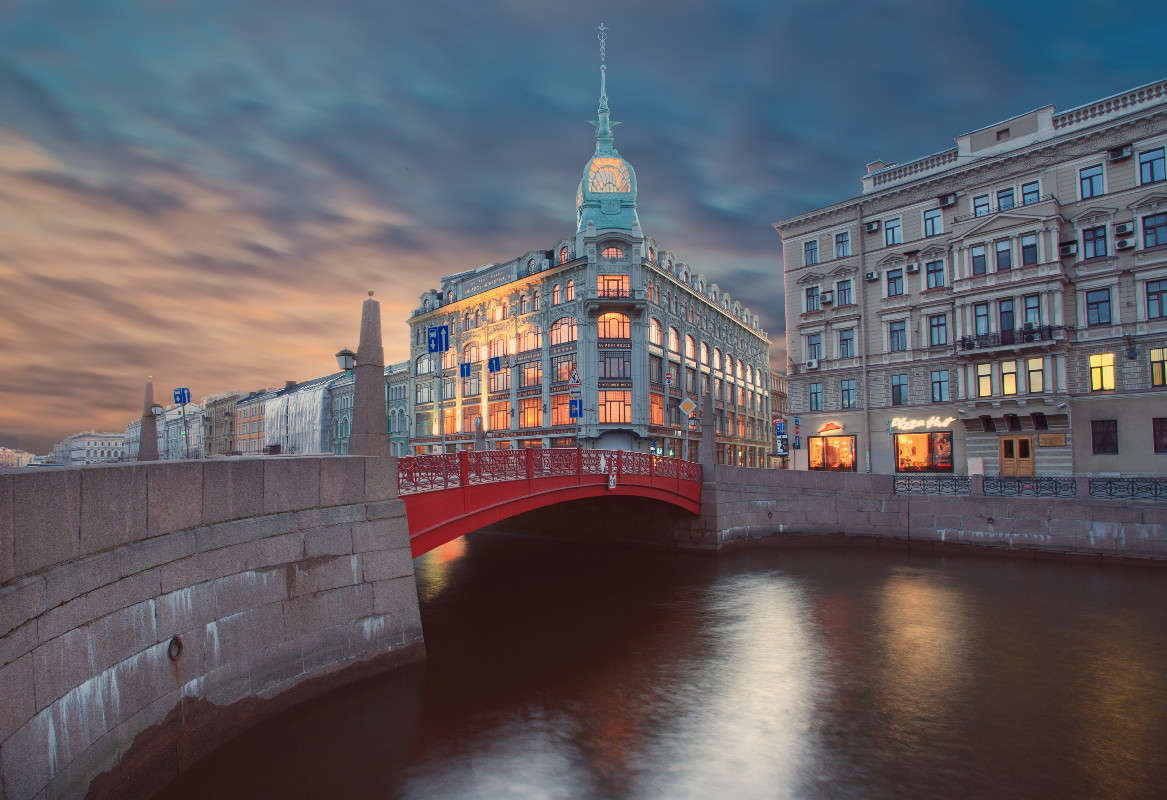
The Red Bridge
Let’s move on, and the Egyptian bridge opens up to our eyes. All structural elements, including the lattice of the bridge, were richly decorated in the then fashionable “Egyptian style”, so the bridge got its name. Academician P.P. Sokolov sculpted four sculptures of sphinxes, on whose heads hexagonal lights were fixed. Today, these sphinxes are the only ones that survived from the original decoration of the bridge. The Egyptian bridge stood for almost 80 years, but on January 20 (February 2), 1905, the unexpected happened. While passing over the bridge of the equestrian grenadier regiment, the bridge collapsed to Fontanka. Three horses became victims of the disaster. The most diverse versions of this incident are still being put forward. Some experts say that the measured passage of the columns caused a resonance. Others point out possible mistakes by designers and builders of the bridge. Instead of the collapsed bridge, a temporary wooden bridge was built, which served until the 1950s, when the bridge was recreated in stone again. The new building did not resemble the old, richly decorated bridge, since the restoration of its former appearance was not the goal of the architects, designed the new bridge more modest and light. However, the preserved Egyptian motifs and cast-iron sculptures of the sphinxes made it possible to leave the former name behind the structure.
A popular urban legend says that a certain Maria Ilyinichna Ratner, who lived near the bridge, during the passage of cavalrymen shouted out the window: “To fail!” and her wishes were immediately fulfilled. The reasons for this bad deed are still unknown. Some believe that Maria Ilyinichna was tired of the pipes and timpani of cavalrymen who woke her every morning; others claim that Ratner in her youth fell victim to the adversary in uniform. Be that as it may, Maria Ilyinichna entered the city folklore under the name “Mary of Egypt.”
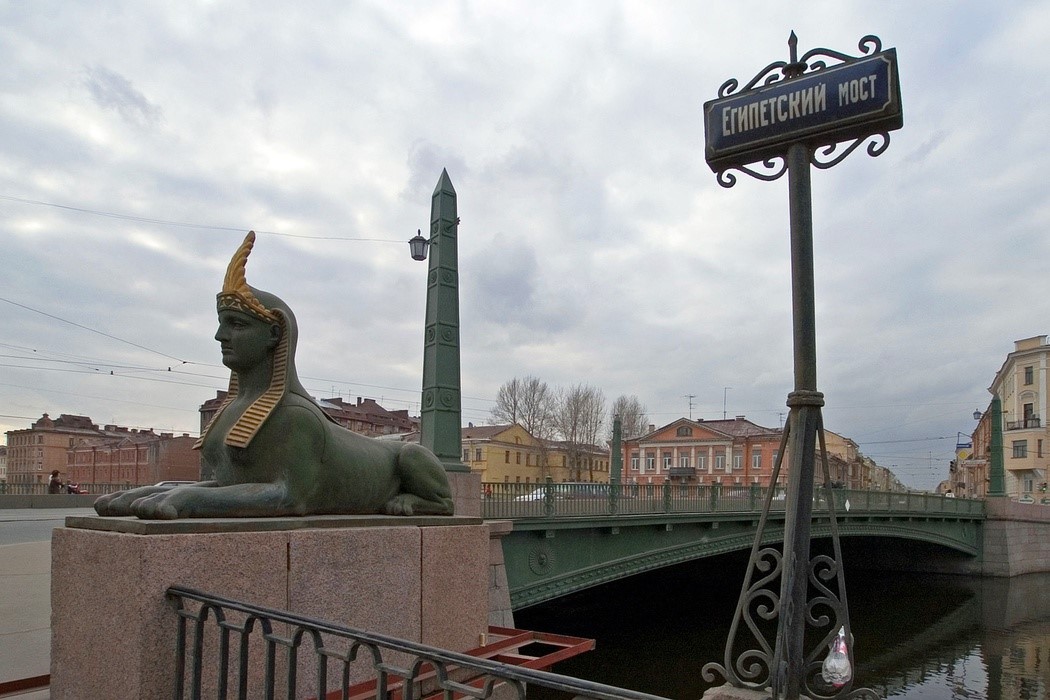
Egyptian bridge
In a couple of moments, we will meet with the Obukhov bridge, thrown over the Fontanka River along the axis of Moscow Avenue, connecting Spassky and Bezymyanny islands. This is a three-span stone structure with a length of 68.8 meters and a width of 31.8 meters. The bridge is oblique in plan, the angle of the kosin is 60 °. The span is a reinforced concrete double-hinged arch, lined with granite. By design – reinforced concrete continuous arches. The abutments and supports are massive, on a pile foundation, lined with granite. On the facades of the bridge, the outlines of arches and ice cutters shaped as trihedral prisms are expressed. Railing is made in the form of a solid granite parapet. At the entrances, granite obelisks rise; at each obelisk 2 round lamps are fixed. The sidewalks are separated from the carriageway by an increased granite parapet fence.
Obukhov bridge is one of the oldest bridges in St. Petersburg. Built across the Fontanka River on the Saar prospect (later Tsarskoye Selo Avenue, now Moscow). The first wooden bridge over the Fontanka River in the alignment of modern Moscow Avenue was built in 1717. In the middle, the bridge had a transverse slit 70 cm wide, intended for passage of mast vessels; in the afternoon this gap was laid with boards. In 1738, the crossing was rebuilt. Until 1738, the bridge did not have an official name. The national name – Obukhov or Obukhov – was assigned to him by the name of the “Posad man” Obukhov who built him. In 1738, the Commission on the St. Petersburg Building established the name “Saar Bridge” for the bridge. It did not take root, and the bridge still retains in its name the memory of a construction contractor – Obukhov. During the construction of the granite walls of the Fontanka embankments in 1785-1786, the wooden bridge was rebuilt into a three-span stone one like the tower bridges of Lomonosov and Staro-Kalinkin. Shore spans were blocked by stone arches, and the middle span was adjustable with a wooden span and with towers on river supports to accommodate the divorce mechanisms. In 1865, the bridge was rebuilt according to the project of engineer Mikhailov. The wooden adjustable span was replaced by a brick vault, and the bridge towers were dismantled. According to the static scheme, the bridge is turned into a three-span jointless arch. By the mid-1930s, the bridge ceased to cope with the increased traffic flow on the International Avenue (the so-called Moscow Avenue in 1918-1950): the bridge was about 16 meters wide and 30.6 meters wide. In addition, subsidence was revealed in the brick vaults of the central span with openings of joints up to 25 mm. In 1939, according to the project of engineer V.V. Demchenko and architect L.A. Noskov bridge was rebuilt into a three-span reinforced concrete.

Obukhov Bridge
The next in our journey will be the Semenovsky bridge, which runs through the Fontanka along the axis of Gorokhovaya Street. The name is from the neighboring barracks of the Life Guards Semyonovsky Regiment. The plans of 1717 marked a wooden bridge, which was closer to the modern Gorstkin bridge; in 1738 he was already in a modern place. In 1788, the bridge was rebuilt according to the standard design of bridges over the Fontanka with characteristic towers. In 1856-1857, the towers were dismantled, the supports were shifted, the spans for the first time in St. Petersburg were blocked by metal beams with solid walls (engineer F. I. Enrold). In 1949, according to the project of engineer P.V. Bazhenov and architect L.A. Noskov, the bridge was overhauled. A new three-span continuous metal span structure was constructed, and the supports were shifted. The sidewalks were laid out on the console, a new railing of art casting was installed.
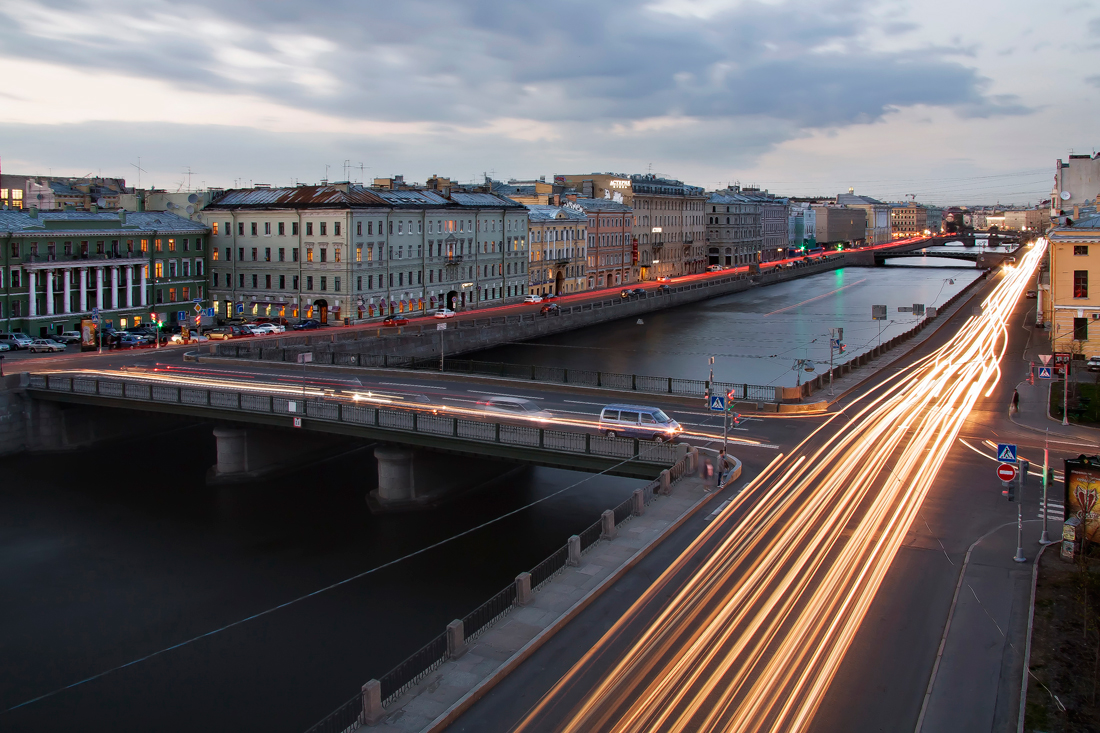
Semenovsky bridge
After this stop, we follow to the Lomonosov (Chernyshev) bridge, built in 1785-1788 and included in a one-of-a-kind ensemble of seven bridges that were thrown over the Fontanka at that time. All seven bridges were absolutely identical in their architectural design and were created according to a standard design by J.R. Perrone. To the chains attached to the pavilion towers, middle adjustable spans were suspended. The emergence of new crossings through the Fontanka was due to the fact that under Catherine II, the central watercourses of St. Petersburg dressed in granite. After the rebuilding of the 19th century, the towers of only two bridges survived – Staro-Kalinkina, which is much lower and Chernyshev Bridge. The latter, in contrast to the enlarged Staro-Kalinkin, almost did not change its appearance. The stone bridge in honor of the empress became known as Catherine. Later it was called the Chernyshev Bridge, along the adjacent lane. The name of the lane, in turn, came from the nearby estate of General Anshef G.P. Chernyshev. The square on the other side of the Fontanka had the same name. The reconstruction of the bridge according to the project of engineer A.P. Pshenitsky and architect I.A. Fomin was carried out in 1912-1913. The chains on the bridge have since played a decorative role, while initially with the help of them the wings of the adjustable span were raised.
In 1912, according to the design of I.A. Fomin, granite obelisks were installed on the bridge. During the siege of Leningrad, Chernyshev bridge was significantly damaged, granite parapets and obelisks were damaged. In 1948, the bridge was given a new name – Lomonosov Bridge, at the same time the name of Lomonosov was given to the square and the lane adjacent to the crossing. Repair work on the Lomonosov bridge in the second half of the 20th century was carried out three times, and in 2005-2006, obelisks were restored.
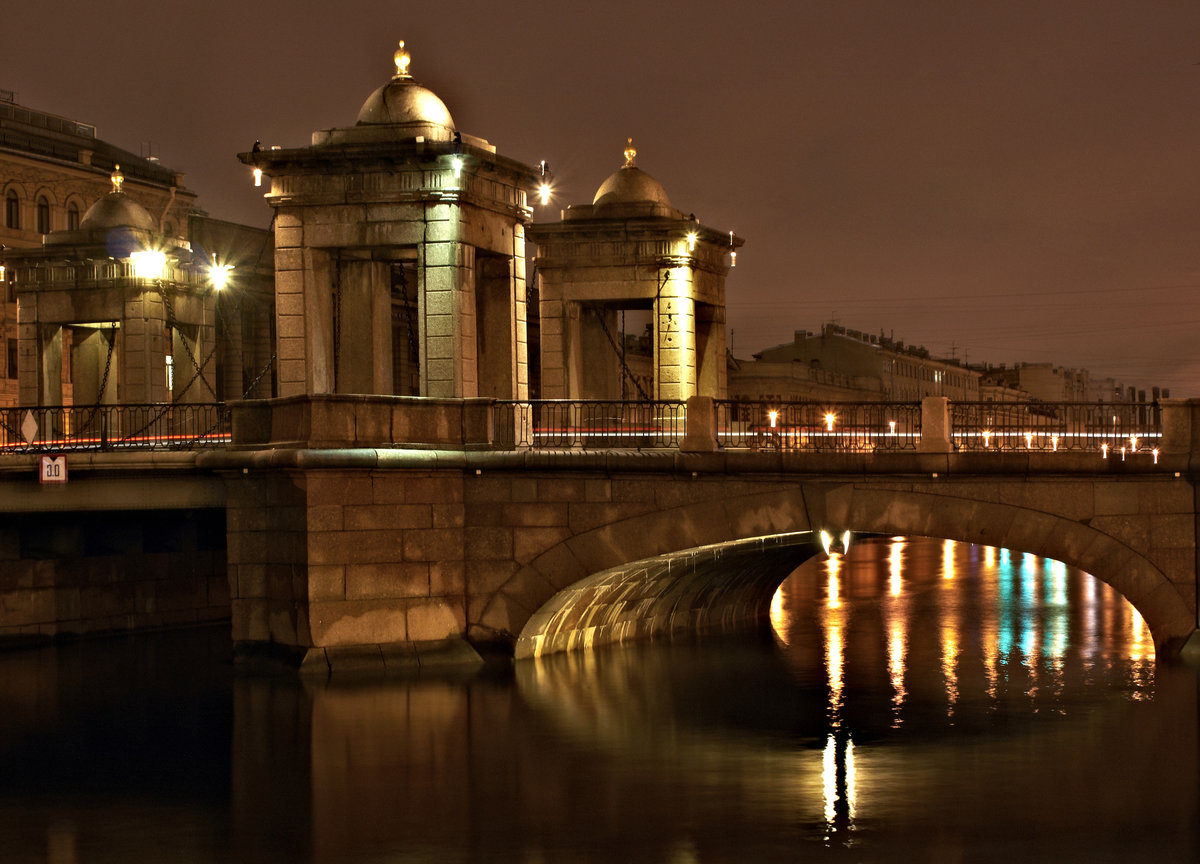
Lomonosov (Chernyshev) bridge
Get ready, now we will see Anichkov bridge – perhaps the most famous St. Petersburg bridge over the Fontanka. It lies in the alignment of Nevsky Prospect. The first wooden bridge appeared here in 1715 by decree of Peter I, then it became borderline for the city. The bridge was named after Lieutenant Colonel M.O. Anichkova, who commanded the construction battalion who built the bridge. The wooden bridge was with a barrier; at night, the barrier was lowered. There was an outpost through which they entered St. Petersburg. At the outpost, they checked passports, took a fee for entry. In 1749, according to the project of architect S. Volkov Anichkov, the bridge was rebuilt. It was thoroughly strengthened, as elephants, a gift from the Persian Shah to the Russian Empress, were supposed to pass through it. The bridge is no longer adjustable. It was planked and decorated with granite. In the 1780s, the banks of the Fontanka were dressed in granite, then through the Fontanka according to the project of J.R. Perrone was built seven of the same type of stone bridges of the tower type. In the years 1783-1787 on a standard project Anichkov bridge was rebuilt. Since that time, it was a three-span granite bridge, the average draw span of which was wooden. On the bulls of the bridge were towers with a swing mechanism. The bridge acquired its present appearance in 1841, when it was rebuilt according to the project of engineer I.F.Butats. The previous crossing turned out to be cramped, as there was already much more Nevsky Prospect. A new stone bridge was built in just six months. All three spans of the bridge were covered with stone arches with granite cladding. The roadway was equal to the width of the avenue. A railing with the image of seahorses, mermaids and dolphins was installed on the bridge, repeating the pattern of the railing of the Palace Bridge over the Spree River in Berlin. It was decided to decorate the foundations of the Anichkov Bridge with sculptures of the “Tamers of Horses” sculptured by P.K. Klodt. Casting of bronze figures began in 1839, and in May 1841 the construction of the bridge began.
In the fall of 1841 the bridge was open to traffic. The success of Klodt’s equestrian groups was extraordinary, it’s enough to say that copies of two groups: “A horse with a young man walking next to him” and a pair of her “A young man who resolutely grabbed a horse under the bridle,” Nicholas I presented to the Prussian king. They were installed at the main gate of the Royal Palace in Berlin. And another copy of these statues was donated to the King of Both Sicilies Ferdinand II, in Naples they took their place near the Royal Palace. Klodt was personally engaged in the manufacture of statues, from sculpting to casting, in the foundry at the Academy of Fine Arts. Signatures on the plinths of statues also remind of this. All four sculptural groups of different contents together constitute a single poem – the taming of a horse by a man. This is an embodiment of man’s struggle with the elements, the forces of nature resist, but gradually man takes over them. The sculptural suite of the Anichkov Bridge is like an allegory of the very idea of bridge building, because each bridge is the result of the battle between the creative genius of a person and the water element and victory over it. Restoration work was carried out in 1906-1908 under the direction of the architect P.V. Schuseva. During the blockade of Leningrad, horse groups were buried in the courtyard of the Anichkov Palace. The bridge was badly damaged by direct bomb attacks. But even before the end of the war, it was restored, and equestrian statues were returned to the place on the eve of May 1, 1945. In 2000, restoration of bronze equestrian groups was carried out, restoration work was led by sculptor V.G. Sorin. In 2008, another overhaul of the bridge was carried out.
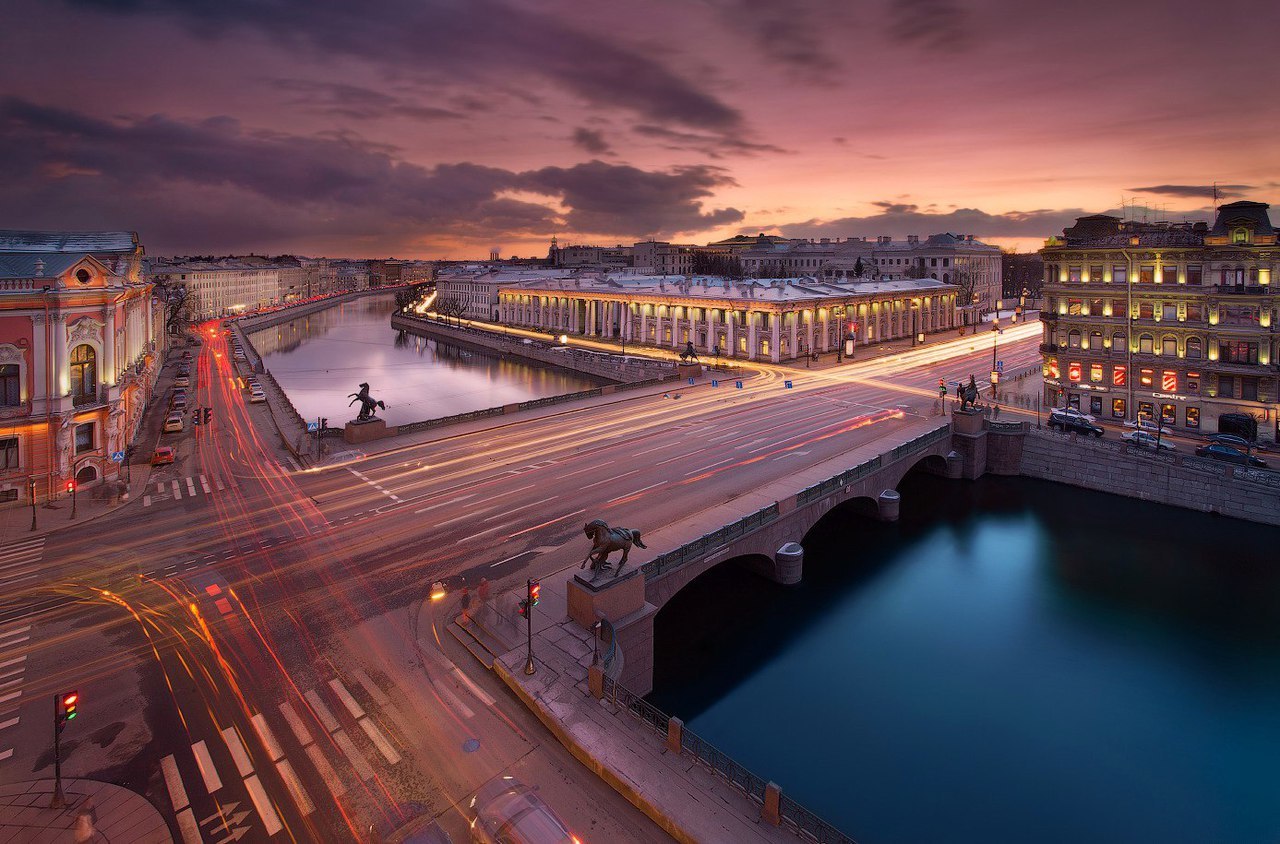
Anichkov Bridge
Feel the approach of big water? Ahead of the Neva – and the first large drawbridge that we will see will be the Liteiny Bridge – the most mystical bridge in St. Petersburg. On the old maps it can be seen that even before the foundation of the city, in the area of the existing bridge, there was a crossing on the way from Russia to Sweden: the Novgorod road ended on one side, the road to Vyborg began on the other. In 1786, in the alignment of Voskresensky Prospekt, the second bridge bridge in the city was built, which was called Voskresensky. Then it was transferred to the Summer Garden and in the same place a new floating bridge was built, which was built up until 1849. Permanent bridge, due to the appearance of tragedy. On April 4, 1865, the floating crossing at Liteiny Prospect was demolished by a stormy ice drift. To study the causes of the accident, a special expert commission was created, but the need for a permanent bridge became apparent. However, the case went slowly. Four years in the City Duma they argued, choosing the place of the future bridge, finally decided that it should connect Liteiny Prospect and the Vyborg side and two years later they announced a project competition. The competition was won by the project under the motto “Westminster”, the authors received a prize, and the Duma decided to proceed with the construction of the bridge. But … – intrigues … investigations … A special commission of the Ministry of Railways said that the project was too expensive. And she reached her goal – the winning project was rejected, and Colonel Engineer A.E. was asked to make a new, “economical” project. Struve (left in the picture). Struve, by the way, was himself a member of the Special Commission. Struve kindly agreed and promised to complete the construction within four years. And finished, but at what cost.

Liteiny Bridge
Trinity (Troitsky) Bridge – the second longest drawbridge in St. Petersburg. Its openwork spans connect Trinity Square and the Field of Mars, acting as the border between the central areas of the city and the Petrograd side. The crossing in this place has been known for a long time – along its axis passes the Pulkovo Meridian, which was actively used by Russian cartographers before moving to Greenwich in the 20th century. This work of Art Nouveau style mixed in itself a truly aristocratic splendor of jewelry and the elegance of an engineering concept. However, it is known not only for its beauty, but also for its rich history. After some time, we will approach the Trinity Bridge – one of the oldest in St. Petersburg. For the first time, the bridge was mentioned in 1827 – as a die-castout (on floating supports) bridge between Suvorov and Troitskaya squares. At that time it was the longest crossing in the whole city. In 1890, the authorities of St. Petersburg recognized the need for reconstruction of the floating bridge and announced a competition. Almost two dozen applicants from different countries fought for first place and an award of 6000 RUB, and Gustave Eiffel’s firm ultimately won. However, Batignol also considered the idea of the Batignol company outside the competition – they proposed an original cantilevered-arch span connection system, which greatly facilitated the design. The bridge was to become not only elegant and unusual, but also less costly, so the project was approved. According to legend, the famous test pilot Valery Chkalov flew under this bridge to achieve the heart of his bride. Whether this is true or not is unknown, but on the set of the film of the same name, the plane flew under it already 6 times.
The opening took place on the anniversary of the 200th anniversary of the city in 1903, and the first bridge was made personally by Emperor Nicholas II. The opening ceremony was also attended by the President of the French Republic, Felix Fora – the rulers symbolically put a coin at the bridge supports. The bridge was renamed several times – in October 1918 it was called the Equality Bridge, in 1934 it was named Kirovsky in memory of the murder of the revolutionary S.M. Kirov, in the same year they removed all plaques with the names of builders. Again it was called Troitsky only on October 4, 1991, during perestroika.

Troitsky Bridge
Further, the famous Palace Bridge opens up to our gaze. From the entire list of attractions that St. Petersburg is literally crammed with, one can still single out several of the most iconic ones. As a rule, St. Isaac’s Cathedral, the Church of the Savior on Blood, the Peter and Paul Fortress are called the symbols of the city. But the panorama of Peter would not be complete without his famous engineering structures – drawbridges. The most picturesque and, perhaps, the most photographed is considered Palace Bridge. Surely, each guest of St. Petersburg has postcards with the wings of the Palace against the background of the spire of the Peter and Paul Fortress. The bridge was originally supposed to be the most beautiful in the city, but throughout its entire existence, fate played a cruel game with it. Nevertheless, the Palace Bridge, practically devoid of architectural refinement, like a magnet attracts thousands of people taking a walk from the Hermitage to the arrow of Vasilyevsky Island. In the middle of the 19th century, shortly after the construction of the city’s first permanent bridge across the Neva (Blagoveshchensky), the pontoon Isaakievsky was moved here to the Winter Palace, which until recently connected University Embankment and Senate Square. After a small cosmetic repair, he received a new name – Palace, in honor of the Winter Palace located literally two steps away. In 1917, the Bolsheviks renamed the Palace Bridge into the Republican. But the new name did not last long, and in 1944 it was replaced by the old one.
But should this be the capital’s bridge, symbolizing the cooperation of the authorities – the Winter Palace and entrepreneurship – the Exchange? Therefore, already in the 80s. The 19th century, it became obvious the need to create a permanent crossing that would connect Vasilievsky Island with the mainland. The final decision to replace the pontoon bridge with a permanent one was made in 1900. The construction of the capital engineering structure began in 1912 and was interrupted in 1914 due to the First World War. As a result, the movement across the bridge was opened in 1916, however, the decoration of the Palace was never completed. By this time, only temporary railing was installed on it and a wooden flooring was laid. Well, then there was no time for jewelry: a revolution took place in Petrograd, and much more important things appeared in the city. During its existence, the bridge was repeatedly reconstructed. In 1998, tram tracks were dismantled from it, the most recent overhaul was carried out recently: in 2013
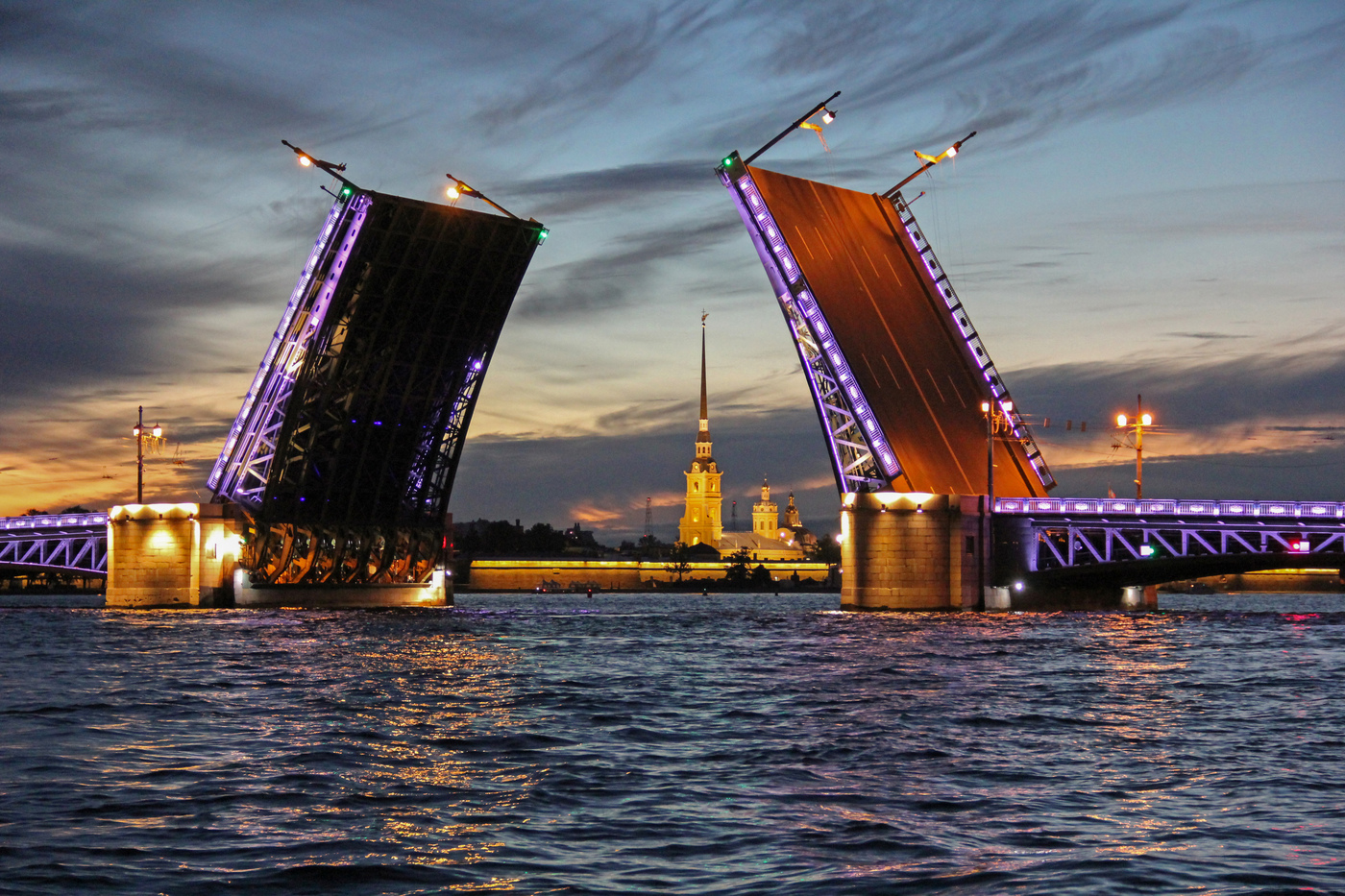
Palace Bridge
Our next bridge will be the Annunciation (Lieutenant Schmidt Bridge). In St. Petersburg, this is the first permanent crossing across the Neva. In the XVIII century, the city was bypassed with floating bridges, since it was believed that the construction of a permanent bridge is a very expensive and complex process. The Annunciation Bridge of St. Petersburg, connecting Vasilievsky Island with the Promenade des Anglais, was at that time the longest in Europe. The first works on the construction of permanent bridges across the Neva appeared in the middle of the XVIII century, but their implementation remained a pipe dream because of the high cost and complexity of the projects. In 1842, it was decided to build a permanent ferry between Vasilievsky Island and Promenade des Anglais, the project was developed by Stanislav Valerianovich Kerbedz, a graduate of the Institute of Railways. The construction of the crossing, which was called Nevskaya, took place in extremely difficult conditions of swampy soil. The number of workers employed in construction was approaching one and a half thousand. Piles were driven with the help of steam engines, air bells were used for underwater operations. The coastal abutments were laid out with granite: Finnish granite was used for the underwater part, and Serdobolsky for the surface part. There is a legend according to which Nicholas I, knowing about the difficulties of construction, ordered to raise Karbedz in the rank for each bridge span erected. Evil tongues claimed that when Kerbedz found out about this, he immediately changed the design, increasing the number of spans. Most likely, this is fiction, but it is known that before the start of construction, Stanislav Veniaminovich was in the rank of captain, and on the day the bridge opened on November 21, 1850, he was promoted to major general.
The artist Alexander Bryullov took part in the design of the bridge. Cast iron railings were cast according to his design, and the engineer D. Tsvetkov created the design of metal gas lanterns. The pillars of the structure were not decorated, this emphasized their “unshakable stability.” It was planned that allegorical sculptures based on drawings by Peter Klodt and Nikolai Pimenov would be installed on the bridge, but this idea had to be abandoned due to lack of funds. Our tour is drawing to a close, the group arrives at the Griboedov Canal and diverges in the rays of the sun leaving the sky.
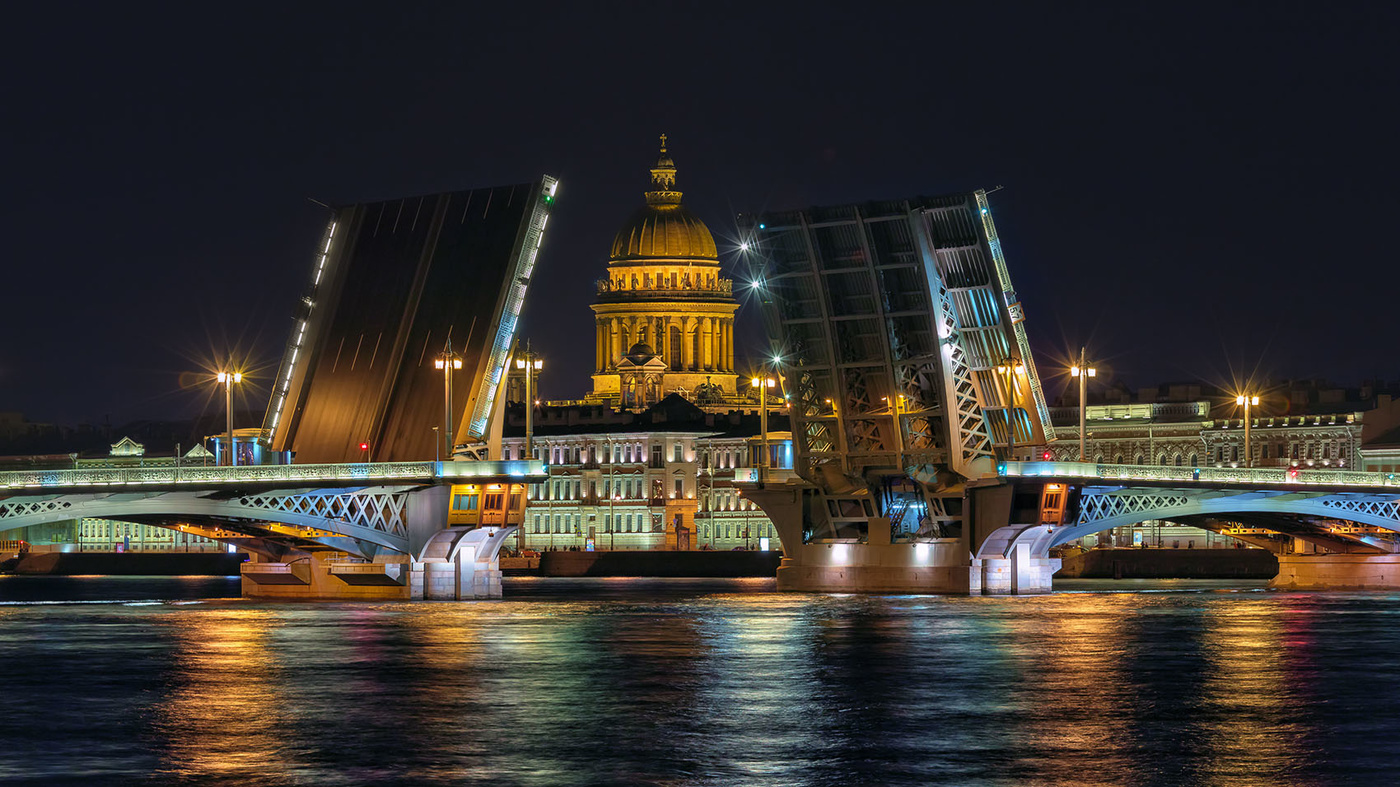
Annunciation (Lieutenant Schmidt) Bridge
Visit Tour Bridges of St. Petersburg and many more that St Petersburg has to offer!
Contact us@ Russian InfoCenter to Book Classic Russia tour 5n/6d and more tour packages from India to Russia
Choose from flights ex Delhi, Mumbai & Calcutta
Fill the form below and we’ll get back to you right away!

